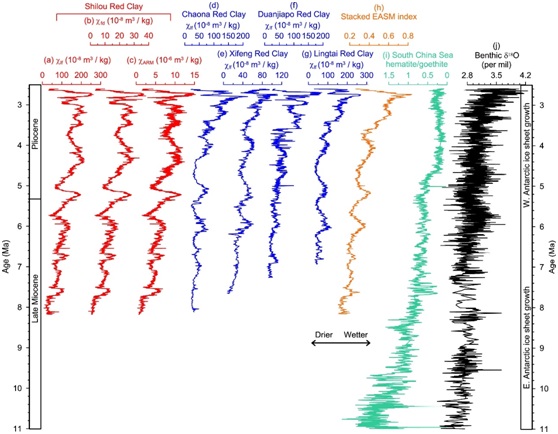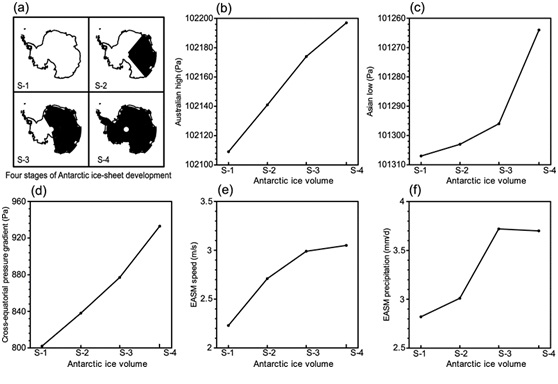Environmental conditions in one of Earth’s most densely populated regions, East Asia, are dominated by the monsoon. The onset age of Asian monsoon system can be traced back to the Eocene or Oligocene, but its pre-Quaternary monsoon variability and dynamics remain enigmatic. While previous studies mainly focused on the Quaternary monsoon variability, pre-Quaternary monsoon studies are rare. In particular, little is known about potential relationships between northern hemispheric monsoon response and major Cenozoic changes in Antarctic ice cover.
The eolian Red Clay sequences underlying the Quaternary loess–paleosol on the Chinese Loess Plateau provide ideal materials for the Neogene monsoon studies. In a study published in the journal Earth and Planetary Science Letters, professor AO Hong from the Institute of Earth Environment, Chinese Academy of Sciences, and his collaborators document long-term East Asian summer monsoon (EASM) intensification through the Late Miocene–Pliocene (~8.2 to 2.6 Ma) from magnetic mineral proxies of the eolian Red Clay on the Chinese Loess Plateau. Combining a numerical climate-model simulation of EASM response to an idealized stepwise increase in Antarctic ice volume, they find that this monsoon intensification can be linked to progressive Antarctic glaciation. They infer that progressive Antarctic glaciation caused intensification of the cross-equatorial pressure gradient between an atmospheric high-pressure cell over Australia and a low-pressure cell over mid-latitude East Asia, as well as intensification of the cross-equatorial sea-surface temperature (SST) gradient. These combined atmospheric and oceanic adjustments led to EASM intensification. Their findings shed new light on the monsoon evolution and offer a new and more global perspective on the controls behind long-term Asian monsoon evolution.
“The idea of AO et al. (EASM control by Antarctic ice sheet growth) is original, plausible, provocative, and timely. It could fill in an important gap in understanding controls on EASM in the interval 8-4 Ma,” said one of the reviewers. Professor AO Hong said, “It is very important for us to recognize that the East Asian summer monsoon precipitation have teleconnections with the Antarctic ice sheets. This may help us to predict future environmental and climatic changes in the densely populated Asia with decreasing global ice sheets under global warming seasons”.

Fig.1 East Asian summer monsoon intensification and progressive Antarctic glaciation during Late Miocene–Pliocene (Image by AO, et al.)

Fig.2 Simulated East Asian summer monsoon responses to four idealized stepwise increases in ice-sheet size from East to West Antarctica. (Image by AO, et al.)
Contact: AO Hong, State Key Laboratory of Loess and Quaternary Geology, Institute of Earth Environment, Chinese Academy of Sciences, Xi’an 710061, China
 © 2015 Institute of Earth Environment,CAS
© 2015 Institute of Earth Environment,CAS Address:No. 97 Yanxiang Road, Xi'an 710061, Shaanxi, China

 Location :
Location :